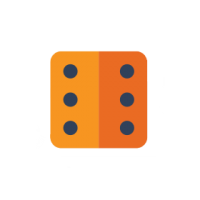Please wait...
The book is divided into three sections: Concepts, Process and Practice.
In the first section, Concepts, the authors take us through the definitions and principles of a play-based approach to game design. By the end of these four chapters, readers will have the terminology and conceptual framework for understanding games and play from a designer’s point of view.
Section two, Process, looks at some of the core processes and techniques through which the iterative design process unfolds. These four chapters introduce important methods and documents that will make the game design process smoother and more enjoyable.
Section three, Practice, then puts game design into action. The five chapters in this section move through the iterative game design process of conceptualizing, prototyping, playtesting and evaluating the design of games as designed play experiences.

The introduction to the book describes the what, why, how and who of Games, Design & Play. We also outline the basic elements of play design: actions, goals, rules, objects, playspace and players.

Chapter 6 describes an important tool for keeping a game’s design on track: what we call design values. We discuss the origins of the concept and tool and describe its use. The chapter concludes with three case studies: thatgamecompany’s Journey, Captain Game’s Desert Golfing, and Naomi Clark’s Consentacle.

To keep the game design process from feeling like an ever-shifting state of chaos, this chapter introduces three kinds of documentation: design documents, schematics, and tracking spreadsheets. Design documents record the specific design decisions made about the game. Schematics illustrate how the design is manifest on-screen to make the abstract ideas partially tangible before being implemented. And tracking spreadsheets capture big-picture and moment-to-moment tasks necessary to design, prototype and playtest a game.
In this chapter 7 excerpt, we include the portion of the chapter covering the design document.

Conceptualization is the start of the gamemaking process. But what will that game be? There’s nothing more daunting than a blank screen, but there’s also no shortage of ideas, people, places, things, dreams and other games to be inspired by. Conceptualizing your game starts with an idea, but it doesn’t end there. Using techniques such as brainstorming, motivations, and design values will help turn those ideas into a game design.
In this chapter 9 excerpt, we include three brainstorming techniques that we’ve found are really helpful in getting started on conceptualizing a game.

The game design course is conceived of as a project-based course, and so students will be playing, modifying and creating games throughout. It begins with the principles of game design, then moves into a series of iterative design cycles. The course uses group work for most assignments as a means of fostering peer learning and giving collaboration opportunities whenever possible.
While this can certainly be used as a soup-to-nuts course, we imagine many faculty will want to modify and supplement based on the particular needs of your program, course and students.
The following are the learning outcomes for the course as designed here:

The game appreciation course is more suitable for humanities and game studies courses. It is a lecture or seminar course, with an emphasis on in-class lecture and discussion building on playing games and material drawn from the book and beyond.
While this can certainly be used as a soup-to-nuts course, we imagine many faculty will want to modify and supplement based on the particular needs of your program, course and students.
The following are the learning outcomes for the course as designed here:
We focus primarily on independent games—because they are often the games at push the boundaries of game design.
“While most texts on game design float in a vague sea of buzzwords and nostalgia, Games, Design and Play is rooted in example after example of real work being done by real game artists. Books on game-making tend to fixate on the technical ‘how to,’ GD&P dabbles in the far more essential ‘why to.’”
anna anthropy, Play Designer, Sorry Not Sorry Games - cththemes.com
“Anyone who seeks to learn or teach about games can use Games, Design and Play as an insightful guide to ideas on how games work, methodologies that help us create new experiences, and pleasures found through play.“
Naomi Clark, Assistant Arts Professor, NYU Game Center and Author of A Game Design Vocabulary -
“The authors share a wealth of experience, making for a text full of great concepts, thorough process and applied practice. Throughout they provide pertinent examples and use engaging exercises which makes it useful, informative and insightful.”
“This is a book that fills the much needed space between systems thinking and play theory. Macklin and Sharp balance the process with practicalities, in a way that is as timeless, enjoyable and engaging as the games they discuss.”
Lindsay Grace, Associate Professor and Founding Director, American University Game Lab and Studio -
“This is one of the most comprehensive game design books to date…. I wish I had a text like this available to me when I was first starting out in my career—it would have made it much easier to come up with a framework for some of the more outlandish ideas I had for games and to communicate them to my teammates.”
Anna Kipnis, Senior Gameplay Programmer, Double Fine Productions -
“I’ve been studying and teaching game design for over a decade and this is the first time I’ve read a book that catalogs so many diverse aspects of the game design process. Colleen and John dissect and examine games of all types (not just videogames) and then expertly show you how to put all the pieces together to form your own unique design.”
“Perhaps most importantly, Games, Design and Play delivers a message to designers that their games will go out into the world and be part of society and culture. The approach is both rich and approachable for undergraduate, graduate and aspiring game developers alike.”
Casey O’Donnell, Associate Professor, Michigan State University and Author of Developer’s Dilemma -
“Sharp and Macklin break down the design process in detail from concept to code to completion. What I particularly like about this book is its inclusion of prototyping methods and design patterns that are often overlooked by others. I suspect it will be helpful to designers looking to break new ground outside the AAA space.”
“Game, Design and Play is a detailed, thoughtful, and well-researched primer on the multifaceted discipline that is game design.”
“There are many books you can read about games. But Games, Design, and Play is something new. Colleen Macklin and John Sharp don’t just explain what games are—they detail the game design process itself.”
Eric Zimmerman, Game Designer & Arts Professor, NYU Game Center -
Games, Design and Play brings together other great books on games and design. Check out this selected bibliography for more great books.
Anthropy, Anna, Rise of the Videogame Zinesters: How Freaks, Normals, Amateurs, Artists, Dreamers, Drop-outs, Queers, Housewives, and People Like You Are Taking Back an Art Form. New York: Seven Stories Press, 2012.
Anthropy, Anna and Naomi Clark. A Game Design Vocabulary: Exploring the Foundational Principles Behind Good Game Design. Boston, MA: Addison-Wesley Professional, 2014.
Burnett, Rebecca, Brandy Blake, Andy Freeze, Kathleen Hanggi and Amanda Madden, WOVEN Text version 2.2. New York: Bedford St. Martin’s, 2012.
Cooper, Alan, The Inmates are Running the Asylum: Why High Tech Products Drive Us Crazy and How to Restore the Sanity. Boston, MA: Sams – Pearson Education, 2004.
Costikyan, Greg. Uncertainty in Games. Cambridge, MA: MIT Press, 2013.
Csikszentmihalyi, Mihaly, Flow: The Psychology of Optimal Experience. New York: Harper Perennial Modern Classics, 2008.
Dreyfuss, Henry, Designing for People. NY: Simon and Shuster, 1955.
Fullerton, Tracy. Game Design Workshop: A Playcentric Guide to Creating Innovative Games, 3rd edition. Bacon Raton, Florida: CRC Press, 2015.
Garrett, Jesse James, The Elements of User Experience: User-Centered Design for the Web and Beyond (2nd Edition). San Francisco, CA: New Riders, 2010.
Hickey, Dave. “The Heresy of Zone Defense”, Air Guitar: Essays on Art and Democracy. Los Angeles, CA: Art Issues Press, 1997.
Isbister, Katherine, How Games Move Us: Emotion by Design. Cambridge, MA: The MIT Press, 2016.
Juul, Jesper, The Art of Failure: An Essay on the Pain of Playing Video Games. Cambridge, MA: The MIT Press, 2013.
Juul, Jesper, Half-Real. Cambridge, MA: The MIT Press, 2005.
Lemarchand, Richard. “Attention, Not Immersion: Making Your Games Better with Psychology and Playtesting, the Uncharted Way”, The Game Developers Conference (talk). 2012.
Llopis, Noel. “Indie Project Managment for One: Tools,” Games from Within. August 5, 2010. http://gamesfromwithin.com/indie-project-management-for-one-tools. Accessed January 29, 2016.
Meadows, Donella. Thinking in Systems: A Primer. White River Junction, VT: Chelsea Green Publishing, 2008.
Norman, Donald, The Design of Everyday Things. New York: Basic Books, 2002.
Nutt, Christian. “Road to the IGF: Lea Schonfelder and Peter Lu’s Perfect Woman” Gamasutra. http://www.gamasutra.com/view/news/211651/Road_to_the_IGF_Lea_Schonfelder_and_Peter_Lus_Perfect_Woman.php. Published Feb 25, 2014. Accessed February 2, 2016.
Osborn, Alex F., Applied Imagination: Principles and Procedures of Creative Problem-solving. New York: Scribner, 1979.
Parsons, Talcott, The Structure of Social Action. New York: Free Press, 1967.
Raskin, Jef. The Humane Interface: New Directions for Designing Interactive Systems. Boston, MA: Addison-Wesley Professional, 1994.
Salen, Katie and Eric Zimmerman. Rules of Play: Game Design Fundamentals. Cambridge, MA: The MIT Press, 2003.
Shewhart, Andrew Walter, Statistical Method from the Viewpoint of Quality Control. Washington, D.C.: The Graduate School, the Department of Agriculture, 1939.
Suits, Bernard. The Grasshopper: Games, Life and Utopia. University of Toronto Press. Buffalo, NY: 1978.

Colleen Macklin is an Associate Professor in Design and Technology at Parsons School of Design in New York City and Co-Director of PETLab (Prototyping Education and Technology Lab), a lab focused on developing games for experimental learning and social engagement. PETLab projects include a curriculum in game design for the Boys and Girls Club, games in disaster preparedness for the Red Cross, and big games such as Re:Activism and the “fiscal” sport Budgetball. She is a member of the game design collective Local No. 12, known for their card game the Metagame. Her work has been shown at Come Out and Play, SoundLab, The Whitney Museum for American Art and Creative Time.

John Sharp is a designer, art historian and educator. He has been involved in the creation and study of art and design for over twenty years. John is a member of the game design collective Local No. 12, which focuses on games as a research platform. He is the Associate Professor of Games and Learning in the School of Art, Media and Technology at Parsons School of Design at The New School where he co-directs PETLab (Prototyping, Education and Technology Lab). His book, Works of Game: On the Aesthetics of Games and Art and Games, was published by The MIT Press.